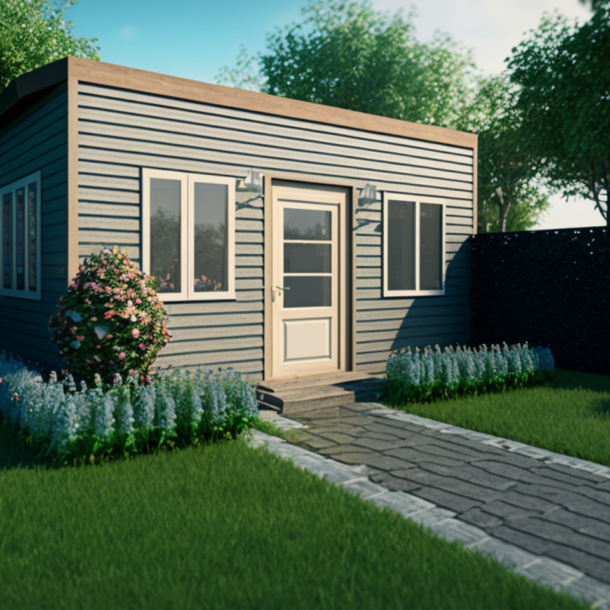
Exploring the Impact of Technology on the Custom Home Building Industry
Exploring the impact; my goodness! Have you experienced the familiar sounds of construction? The echoing hammers pounding, saws buzzing, and trucks beeping have long provided the soundtrack of human progress. Yet today, a new note mingles with this age-old melody, suggesting a technological revolution that is gradually sweeping through the custom home-building industry.
The advent of drones, virtual reality tools, robots, and new materials such as 3D-printed concrete are all contributing to the transformation of modern industry. These fortunate technological advances optimize efficiency, scheduling, budgeting, and quality control at every phase of the home-building process, from design to construction.
The benefits of using supreme technology in custom home building are countless. For builders and contractors, productivity, precision, safety, and collaboration are all easily improved. The high-pitched whir of drones floats over job sites, surveying the landscape below with an efficiency and objectivity human eyes alone could never accomplish.
Meanwhile, the heavy impression of robot helpers echoes across freshly poured foundations as they haul materials, lay bricks, and handle repetitive tasks with tireless precision. Humans, too, can imitate but can hardly compete!
Surely, a technological revolution is transforming the custom home-building industry before our very eyes. What was once an enterprise built upon human labor, craft, and intuition is now rapidly embracing a new set of digital and automated means.
Undoubtedly, technology has transformed nearly every industry, and the custom home-building industry is no exception. Profound technologies like 3D modeling, robotics assistants, and predictive analytics provide remarkable opportunities to improve efficiency, reduce costs, and construct stunning custom homes. Simultaneously, they also present challenges that builders must navigate thoughtfully.
On the favorable side, these technologies enable designers and architects to envision dream homes like never before. For instance, 3D modeling software allows them to explore layouts, exterior designs, and finishes in an immersive virtual environment before breaking ground. This eliminates countless hours of brainstorming adjustments and modifications after construction initiates. Builders can now collaborate with clients in real-time using 3D models, ensuring a thorough understanding of the vision before committing to construction.
Predictive analytics and other assistants also have the power to transform key aspects of home building. They can recommend optimal design features based on client preferences, lifestyle needs, and trends to spark creativity. Furthermore, analytics can pinpoint inefficiencies, bottlenecks, and cost overages early to redirect projects back on track. Drones, IoT devices, and robotics are also reducing labor costs, speeding up repetitive tasks, and improving safety.
However, these technologies also threaten to dehumanize the custom home-building experience if not implemented carefully and compassionately. There is a lingering risk that technology ends up driving design more than fulfilling clients’ dreams. Nevertheless, integrating these new technologies into an industry long dominated by hands-on work presents enormous potential benefits.
Here are some of the biggest impacts technology has had on custom home construction.
Chosen Materials:
The modern materials available to custom home builders have brought about a world of possibilities and truly remarkable transformations. Advanced composites and space-age metals now allow for sleek and curved designs that were once unimaginable.
Engineered timbers and composite woods provide the strength needed to create long, swooping roof lines without the need for bulky support beams that obstruct the view. Synthetic stone and brick options offer an extensive palette of colors and textures, resulting in walls that appear intricately carved by an artist’s hands.
Insulation products have undergone a significant evolution, transitioning from bulky to barely noticeable while achieving exceptional efficiency. They no longer encroach on valuable interior space. Likewise, windows have become almost magical, with transparent panes fitting seamlessly into razor-thin frames, effectively maintaining comfortable indoor temperatures while enhancing the aesthetic appeal of the home.
These marvelous modern materials are like genies granting wishes for dream home designs. Gone are the days when conventional shapes and forms limited our imagination. Custom builders now have the ability to craft homes that soar with sculptural structures infused with the spirit and vision of their discerning clients.
These materials not only provide incredible functionality and strength but also offer a wide range of options to create visually stunning and architecturally unique homes. With these modern materials, custom builders can bring their clients’ dreams to life, pushing the boundaries of design and creating homes that stand out as true works of art.
High-end Machinery:
In the current home building industry, technology has introduced a host of advanced machinery to construction sites, providing assistance to human hands in the creation of your dream home. Just take a look at the powerful tools available, such as excavators and graders, which shape the earth with laser precision to create a perfectly level foundation.
We cannot overlook the impact of pavers and rollers, which produce smooth surfaces that are built to withstand the test of time. Computerized framing machines have the ability to cut complex joints with pinpoint accuracy, allowing walls to rise swiftly. Additionally, robotic assistants tirelessly spray insulation and tape drywall seams, working overnight to keep projects on schedule.
Lifting devices play a crucial role as well, raising towers high into the sky and safely transporting workers to dizzying heights for the installation of trusses, wiring, and ductwork. This orchestration of machinery, guided by human builders, performs a symphony that brings your vision to life with increased speed and efficiency.
With the aid of technological multipliers, teams with fewer hands can complete projects in less time. These machines enhance the abilities of skilled craftsmen, programmed by the human spirit of wonder and innovation. Technology serves as a tool to extend and augment our natural hands and minds, rather than replacing them.
The integration of high-end machinery in the home building process allows for improved productivity, precision, and efficiency. It enables builders to achieve remarkable results while reducing construction time, ultimately bringing your dream home to fruition with greater speed and accuracy.
3D Modeling and Design Software:
In the past, custom home plans existed solely in the realm of imagination. However, the emergence of design software has opened up a new virtual world where designs can be meticulously crafted, refined, and perfected even before becoming a reality.
With a simple click of a mouse, builders can now walk through impressive 3D home models, examining every intricate detail. They can hover and navigate through rooms, analyzing aspects such as light, airflow, proportions, and flow, and making modifications accordingly. Through sophisticated simulations, they can visualize how walls, windows, and insulation will appear and perform, eliminating uncertainties prior to construction commencement.
Furthermore, complex elements such as joints and curved timber frames can be designed, tested, and even fabricated digitally before a single board is cut on-site. This ability to visualize, analyze, and refine designs virtually has been truly transformative for the industry.
Consider the fact that errors, which once required time and money to rectify during construction, can now be identified and rectified on the computer screen, saving significant headaches and hassle. Builders can even “live” with the digital design for months, experiencing it as if it were already constructed, which allows them to uncover any lingering issues or identify potential improvements.
The implementation of 3D modeling and design software has revolutionized the custom home-building process. It empowers builders to create more accurate and refined designs, reduces the likelihood of errors, enhances collaboration with clients, and ultimately leads to more efficient and successful construction projects. This innovative technology has become an invaluable tool in the arsenal of custom home builders, pushing the boundaries of what is possible and enabling the creation of truly exceptional homes.
Additive Construction:
Additive construction techniques are ushering in a new era of limitless creativity in custom home design. Advanced methods such as 3D printing and robotic deposition enable builders to envision dramatic forms that were once unimaginable using traditional techniques.
These techniques make it possible to create houses with freeform exterior shapes, interior walls that curve and bend to enhance the flow of movement and light, and complex structural elements that seamlessly blend art and function. Every bespoke detail can be precisely tailored to fulfill a client’s unique vision.
In truth, additive techniques empower a new form of mass customization for homes, offering the potential to produce one-of-a-kind designs at an industrial scale. There is no longer a need to be confined by the rectangular boxes of conventional construction. Architects and builders are now free to imagine homes that cradle and celebrate the human spirit in extraordinary and awe-inspiring ways.
The pioneering structures already created with 3D printing and robotic deposition provide a glimpse into the potential of this additive approach. These houses feature spiral staircases that invite exploration, curves that embrace open living spaces, and intricate timber frames that poetically support ethereal walls of light.
As these additive construction techniques continue to evolve and mature, they will enable dreamers and builders alike to design and bring to life homes that invigorate the soul in previously unimaginable ways. The possibilities for innovative and transformative architectural creations are boundless.
Smart Home Features and Automation:
For discerning clients seeking more than a basic home, smart home technology offers tailored solutions that cater to their unique needs, wishes, and preferences.
Builders integrate connected lighting, climate control, security, and appliances into the design, granting residents effortless control over their home. Voice commands can summon desired lighting, adjust temperatures for comfort, and operate appliances with convenience. Shades and locks respond to the owner’s desires seamlessly.
This level of personalized control transforms a house into a smart home, curated to anticipate needs and enhance the joy of living. It offers a sanctuary that exceeds expectations and provides comfort with seamless technology.
Smart home features offer more than just convenience; they embody personalized luxury. Technologists and builders harness automation elegantly to enhance human comfort, joy, and well-being.
Intelligently chosen, smart home technology becomes an invisible genie within the walls, granting residents a living experience that aligns with their refined wishes for convenience and comfort.
Overall, smart home features and automation provide bespoke solutions that enhance comfort and luxury in a way that was previously unimaginable.
Conclusion:
As a custom homebuilder navigating the changing landscape of technology, I am both excited and cautious about the advancements that have revolutionized the design and construction process. From drones and 3D scanners to robotics, these tools offer tremendous improvements at every stage of the journey.
I have witnessed firsthand how these digital processes can identify structural issues, increase efficiency, streamline communication, and reduce errors. Homeowners benefit from a tailored dwelling that aligns with their needs, budget, and vision.
However, as promising as these technologies are, they cannot replace the intuition and wisdom gained from years of experience. They cannot replicate the creative spirit that drives our design or the skill of craftsmen who have honed their craft over decades.
At their worst, these technologies risk reducing the art of homebuilding to a purely optimized production process, devoid of heart and soul. The key lies in finding a symbiotic balance, blending new tools with traditional building techniques in a collaborative and gradual manner.
We must remain open-minded yet discerning, embracing new methods while preserving the human values that define our work. We should not simply hand over control to machines and algorithms but rather shape them to serve our purposes.
Robots can assist human laborers, algorithms can guide architects’ visions, and sensors can generate data to optimize new structures. We find ourselves at the dawn of a hybrid ecosystem where we navigate the language of bits and bytes.
Ultimately, homebuilding has always been a fusion of faith, vision, and technical skill. The best use of these new technologies is to enhance and amplify our creative capacity rather than replace it. As we move forward, we must guide their development with the wisdom gained through the union of hand and heart.
Quick links
Head Office and Design Center
Operating Hours
Monday to Friday : 9AM – 6PM
Saturday : 10AM – 5PM
Sunday : By appointment only


